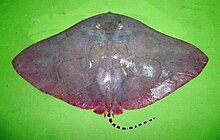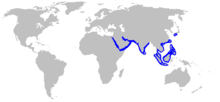| Longtail butterfly ray | |
|---|---|

| |
| Scientific classification | |
| Domain: | Eukaryota |
| Kingdom: | Animalia |
| Phylum: | Chordata |
| Class: | Chondrichthyes |
| Subclass: | Elasmobranchii |
| Order: | Myliobatiformes |
| Family: | Gymnuridae |
| Genus: | Gymnura |
| Species: | G. poecilura
|
| Binomial name | |
| Gymnura poecilura (G. Shaw, 1804)
| |

| |
| Range of the longtail butterfly ray[1] | |
| Synonyms | |
|
Pastinaca kunsa Cuvier, 1829 | |
The longtail butterfly ray (Gymnura poecilura) is a species of butterfly ray, family Gymnuridae, native to the Indo-Pacific from the Red Sea to southern Japan and western Indonesia. Growing up to 92 cm (36 in) across, this ray has a lozenge-shaped pectoral fin disc about twice as wide as long, colored brown to gray above with many small, light spots. The spiracles behind its eyes have smooth rims. This species can be identified by its tail, which is about as long as the snout-to-vent distance, lacks fins, and bears nine to twelve each of alternating black and white bands.
Bottom-dwelling in nature, the longtail butterfly ray frequents sandy or muddy habitats in coastal waters shallower than 30 m (98 ft). Its diet consists of bony fishes, molluscs, and crustaceans. This species gives birth to live young; the developing embryos are nourished first by yolk and later by histotroph ("uterine milk") supplied by its mother. There is no defined breeding season, and females bear litters of up to seven pups. Used for its meat, the longtail butterfly ray is often caught by artisanal and commercial fisheries.
- ^ a b Sherman, C.S.; Akhilesh, K.V.; Bin Ali, A.; Bineesh, K.K.; Derrick, D.; Dharmadi, Ebert, D.A.; Fahmi, Fernando, D.; Haque, A.B.; Maung, A.; Seyha, L.; Tanay, D.; Tesfamichael, D.; Utzurrum, J.A.T.; Valinassab, T.; Vo, V.Q.; Yuneni, R.R. (2021). "Gymnura poecilura". IUCN Red List of Threatened Species. 2021: e.T60117A124440205. doi:10.2305/IUCN.UK.2021-1.RLTS.T60117A124440205.en. Retrieved 16 November 2021.
{{cite journal}}: CS1 maint: multiple names: authors list (link)
